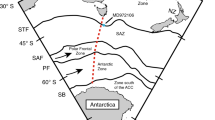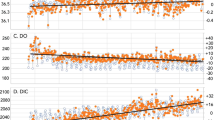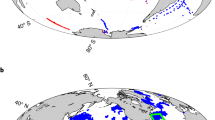Abstract
THE oceans act as both sources and sinks for the carbon dioxide in the air. A partial pressure of CO2 in the water is established which depends on its physical, chemical and biological properties. Carbon dioxide in the surface waters of the Pacific Ocean was measured by Keeling et al.1, who found high concentrations relative to the atmospheric CO2 in a broad belt near the equator. At higher latitudes in the Central Pacific Ocean, concentrations were nearly in equilibrium with the atmosphere, or slightly lower. In order to interpret the role of CO2 in the surface waters of the world's oceans, and its effects on the atmosphere, it is necessary to extend these observations into the polar seas.
This is a preview of subscription content, access via your institution
Access options
Subscribe to this journal
Receive 51 print issues and online access
$199.00 per year
only $3.90 per issue
Buy this article
- Purchase on Springer Link
- Instant access to full article PDF
Prices may be subject to local taxes which are calculated during checkout
Similar content being viewed by others
References
Keeling, C. D., Rakestraw, N. W., and Waterman, L. S., J. Geophys. Res., 70 (24), 6087 (1965).
Kelley, jun., J. J., Ann. Rep. No. 6, Contract ONR 477(24) (Department of Atmospheric Sciences, University of Washington, Seattle, Washington, December 1966).
Author information
Authors and Affiliations
Rights and permissions
About this article
Cite this article
KELLEY, J. Carbon Dioxide in the Seawater under the Arctic Ice. Nature 218, 862–864 (1968). https://doi.org/10.1038/218862a0
Received:
Published:
Issue Date:
DOI: https://doi.org/10.1038/218862a0
This article is cited by
-
Oxygen-carbon dioxide-nutrients relationships in the Southeastern Region of the Bering Sea
Journal of the Oceanographical Society of Japan (1972)
-
Carbon Dioxide in the Surface Water of the Ice-covered Bering Sea
Nature (1971)
Comments
By submitting a comment you agree to abide by our Terms and Community Guidelines. If you find something abusive or that does not comply with our terms or guidelines please flag it as inappropriate.



